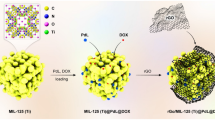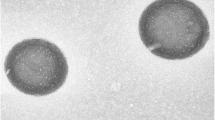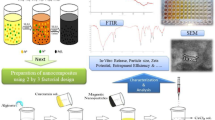Abstract
The fight against infectious bacterial diseases has been taking major steps forward by designing new nanodrugs and nanoscale biological carriers with unique physicochemical properties. Here, polyethylene glycol (PEG)-silica mesoporous material/superparamagnetic CuFe2O4 nanoparticle nanocomposite was synthesized using a facile chemical approach, and proposed as a carrier for the delivery of cefotaxime (CTX) drug. The resulting nanocomposite material and nanocomposite CTX drug carrier were characterized by different techniques. Antibacterial activity of the nanocomposite drug carrier was investigated against E.coli and S. aureus bacteria, and compared with that of commercial CTX drug. It was found that the minimum inhibitory concentrations of the nanocomposite drug carrier (1.25 and 5 μg/mL) were significantly less than those of the commercial drug (10 and 80 μg/mL) against the bacteria. Furthermore, enhanced performance of the nanocomposite CTX carrier for both the Gram-negative and Gram-positive bacteria was evidenced.





Similar content being viewed by others
Availability of data and material
The data will be available upon reasonable request.
Code availability
Not applicable.
Abbreviations
- CTX:
-
Cefotaxime
- NPs:
-
Nanoparticles
- PEG:
-
Polyethylene glycol
- SMM:
-
Silica mesoporous material
- CuFO:
-
CuFe2O4 NPs
- MIC:
-
Minimum inhibitory concentration
References
Al-Shehri BM, Abd El Rahman SK, Ashour SS, Hamdy MS (2019) A review: the utilization of mesoporous materials in wastewater treatment. Mater Res Exp 6(12):122002
Baquero F (2021) Threats of antibiotic resistance: an obliged reappraisal. Int Microbiol 24(4):499–506. https://doi.org/10.1007/s10123-021-00184-y
Batabyal B (2019) Urinary tract infection in children and antimicrobial resistance pattern: children UTI and antibiotic resistance. Educreation Publishing, New Delhi
Biemer JJ (1973) Antimicrobial susceptibility testing by the Kirby-Bauer disc diffusion method. Ann Clin Lab Sci 3(2):135–140
Bloom DE, Cadarette D (2019) Infectious disease threats in the twenty-first century: strengthening the global response. Front Immunol 10:549
Bogush G, Zukoski Iv C (1991) Uniform silica particle precipitation: an aggregative growth model. J Colloid Interfac Sci 142(1):19–34
Breijyeh Z, Jubeh B, Karaman R (2020) Resistance of gram-negative bacteria to current antibacterial agents and approaches to resolve it. Molecules 25(6):1340
Chang Y-P, Tang M, Chen Y-P (2008) Micronization of sulfamethoxazole using the supercritical anti-solvent process. J Mater Sci 43(7):2328–2335
Chen Y (2013) Drug-to-antibody ratio (DAR) by UV/Vis spectroscopy antibody-drug conjugates. Springer, Heidelberg, pp 267–273
Coban AY, Birinci A, Ekinci B, Durupinar B (2004) Drug susceptibility testing of Mycobacterium tuberculosis by the broth microdilution method with 7H9 broth. Mem Inst Oswaldo Cruz 99(1):111–113
Corrêa RC, Heleno SA, Alves MJ, Ferreira IC (2020) Bacterial resistance: antibiotics of last generation used in clinical practice and the arise of natural products as new therapeutic alternatives. Curr Pharm Des 26(8):815–837
Dizaj SM, Lotfipour F, Barzegar-Jalali M, Zarrintan MH, Adibkia K (2014) Antimicrobial activity of the metals and metal oxide nanoparticles. Mater Sci Eng C 44:278–284
Fotukian SM, Barati A, Soleymani M, Alizadeh AM (2020) Solvothermal synthesis of CuFe2O4 and Fe3O4 nanoparticles with high heating efficiency for magnetic hyperthermia application. J Alloys Compd 816:152548
Grayson ML, Cosgrove SE, Crowe S et al (2017) Kucers’ the use of antibiotics: a clinical review of antibacterial, antifungal, antiparasitic, and antiviral drugs, -three volume set. CRC Press, Boca Raton
He Q, Shi J (2011) Mesoporous silica nanoparticle based nano drug delivery systems: synthesis, controlled drug release and delivery, pharmacokinetics and biocompatibility. J Mater Chem 21(16):5845–5855
Heidari S, Haghighi M, Shabani M (2020) Sono-photodeposition of Ag over sono-fabricated mesoporous Bi2Sn2O7-two dimensional carbon nitride: type-II plasmonic nano-heterojunction with simulated sunlight-driven elimination of drug. Chem Eng J 389:123418
Heydari A, Mehrabi F, Shamspur T, Sheibani H, Mostafavi A (2018) Encapsulation and controlled release of vitamin b2 using peracetyl-β-cyclodextrin polymer-based electrospun nanofiber scaffold. Pharm Chem J 52(1):19–25
Huh AJ, Kwon YJ (2011) “Nanoantibiotics”: a new paradigm for treating infectious diseases using nanomaterials in the antibiotics resistant era. J Control Releas 156(2):128–145
Hussain Z, Yousif E, Ahmed A, Altaie A (2014) Synthesis and characterization of Schiff’s bases of sulfamethoxazole. Organ Med Chem Lett 4(1):1–4
Kang H-Y, Wang HP (2013) Preparation of magnetic recoverable nanosize Cu–Fe2O3/Fe photocatalysts. Environ Sci Technol 47(13):7380–7387
Kecht J, Schlossbauer A, Bein T (2008) Selective functionalization of the outer and inner surfaces in mesoporous silica nanoparticles. Chem Mater 20(23):7207–7214
Khezerlou A, Alizadeh-Sani M, Azizi-Lalabadi M, Ehsani A (2018) Nanoparticles and their antimicrobial properties against pathogens including bacteria, fungi, parasites and viruses. Microb Pathog 123:505–526
Kurtuldu F, Mutlu N, Michálek M et al (2021) Cerium and gallium containing mesoporous bioactive glass nanoparticles for bone regeneration: bioactivity, biocompatibility and antibacterial activity. Mater Sci Eng C 124:112050
Liu L, Zhang Y, Zhang L et al (2012) Highly specific revelation of rat serum glycopeptidome by boronic acid-functionalized mesoporous silica. Anal Chim Acta 753:64–72
Makvandi P, Wang C-y, Zare EN, Borzacchiello A, Niu L-n, Tay FR (2020) Metal‐based nanomaterials in biomedical applications: antimicrobial activity and cytotoxicity aspects. Adv Funct Mater 30:1910021
Matheron M, Bourgeois A, Brunet-Bruneau A et al (2005) Highly ordered CTAB-templated organosilicate films. J Mater Chem 15(44):4741–4745
Mehrabi F, Shamspur T, Mostafavi A, Hakimi H, Mohamadi M (2021) Inclusion of sulfamethoxazole in a novel CuFe2O4 nanoparticles/mesoporous silica-based nanocomposite: Release kinetics and antibacterial activity. Appl Organomet Chem 35(1):e6035
Mehrabi F, Shamspur T, Mostafavi A, Saljooqi A, Fathirad F (2017) Synthesis of cellulose acetate nanofibers and its application in the release of some drugs. J Nanomed Res 2(3):199–207
Najmoddin N, Beitollahi A, Kavas H et al (2014) XRD cation distribution and magnetic properties of mesoporous Zn-substituted CuFe2O4. Ceram Int 40(2):3619–3625
Salem H, Samir E (2018) Determination of cefotaxime, cefoperazone, ceftazidime and cefadroxil using surface plasmon resonance band of silver nanoparticles. Braz J Pharm Sci. 54(3). https://doi.org/10.1590/s2175-97902018000317565
Siafaka P, Okur ME, Ayla Ş, Er S, Cağlar EŞ, Okur NÜ (2019) Design and characterization of nanocarriers loaded with levofloxacin for enhanced antimicrobial activity; physicochemical properties, in vitro release and oral acute toxicity. Braz J Pharm Sci. https://doi.org/10.1590/s2175-97902019000118295
Tadjarodi A, Jalalat V, Zare-Dorabei R (2013) Synthesis and characterization of functionalized SBA-15 Mesoporous Silica by N, N-Bis (salicylidene) ethylenediamine Schiff-Base. J Nanostruct 3(4):477–482
Wang L, Hu C, Shao L (2017) The antimicrobial activity of nanoparticles: present situation and prospects for the future. Int J Nanomedicine 12:1227
Yu M, Zhang G, Li P et al (2021) Acid-activated ROS generator with folic acid targeting for bacterial biofilm elimination. Mater Sci Eng C 127:112225
Zhang C, Sun R, Xia T (2020) Adaption/resistance to antimicrobial nanoparticles: will it be a problem? Nano Today 34:100909
Funding
This study was supported by grants from the University of Kashan and the Graduate University of Advanced Technology of Kerman.
Author information
Authors and Affiliations
Corresponding author
Ethics declarations
Conflict of interest
The authors declare that they have no conflict of interest.
Consent for publication
By submitting the manuscript, the authors understand that the material presented in this manuscript has not been published before, nor has it been submitted for publication to another journal. The corresponding author attests that this study has been approved by all the co-authors concerned.
Additional information
Communicated by Erko Stackebrandt.
Publisher's Note
Springer Nature remains neutral with regard to jurisdictional claims in published maps and institutional affiliations.
Rights and permissions
About this article
Cite this article
Salehi, A., Behpour, M. & Afzali, D. PEG-mesoporous material modified by superparamagnetic nanoparticles as a delivery system of cefotaxime. Arch Microbiol 204, 322 (2022). https://doi.org/10.1007/s00203-022-02937-3
Received:
Revised:
Accepted:
Published:
DOI: https://doi.org/10.1007/s00203-022-02937-3




